Intel Unveils Lunar Lake Architecture: New P and E cores, Xe2-LPG Graphics, New NPU 4 Brings More AI Performance
by Gavin Bonshor on June 3, 2024 11:00 PM ESTNew NPU: Intel NPU 4, Up to 48 Peak TOPS
Perhaps Intel's main focal point, from a marketing point of view, is the latest generational change to its Neural Processing Unit or NPU.Intel has made some significant breakthroughs with its latest NPU, aptly called NPU 4. Although AMD disclosed a faster NPU during their Computex keynote, Intel claims up to 48 TOPS of peak AI performance.NPU 4, compared with the previous model, NPU 3, is a giant leap in enhancing power and efficiency in neural processing. The improvements in NPU 4 have been made possible by achieving higher frequencies, better power architectures, and a higher number of engines, thus giving it better performance and efficiency.
In NPU 4, these improvements are enhanced in vector performance architecture, with higher numbers of compute tiles and better optimality in matrix computations.This incurs a great deal of neural processing bandwidth; in other words, it is critical for applications that demand ultra-high-speed data processing and real-time inference. The architecture supports INT8 and FP16 precisions, with a maximum of 2048 MAC (multiply-accumulate) operations per cycle for INT8 and 1024 MAC operations for FP16, clearly showing a significant increase in computational efficiency.
A more in-depth look at the architecture reveals increased layering in the NPU 4. Each of the neural compute engines in this 4th version has an incredibly excellent inference pipeline embedded — comprising MAC arrays and many dedicated DSPs for different types of computing. The pipeline is built for numerous parallel operations, thus enhancing performance and efficiency. The new SHAVE DSP is optimized to four times the vector compute power it had in the previous generation, enabling more complex neural networks to be processed.
A significant improvement of NPU 4 is an increase in clock speed and introducing a new node that doubles the performance at the same power level as NPU 3. This results in peak performance quadrupling, making NPU 4 a powerhouse for demanding AI applications. The new MAC array features advanced data conversion capabilities on a chip, which allow for a datatype conversion on the fly, fused operations, and layout of the output data to make the data flow optimal with minimal latency.
The bandwidth improvements in NPU 4 are essential to handle bigger models and data sets, especially in transformer language model-based applications. The architecture supports higher data flow, thus reducing the bottleneck and ensuring it runs smoothly even when in operation. The DMA (Direct Memory Access) engine of NPU 4 doubles the DMA bandwidth—an essential addition in improving network performance and an effective handler of heavy neural network models. More functions, including embedding tokenization, are further supported, expanding the potential of what NPU 4 can do.
The significant improvement of NPU 4 is in the matrix multiplication and convolutional operations, whereby the MAC array can process up to 2048 MAC operations in a single cycle for INT8 and 1024 for FP16. This, in turn, makes an NPU capable of processing much more complex neural network calculations at a higher speed and lower power. That makes a difference in the dimension of the vector register file; NPU 4 is 512-bit wide. This implies that in one clock cycle, more vector operations can be done; this, in turn, carries on the efficiency of the calculations.
NPU 4 supports activation functions and a wider variety is available now that supports and treats any neural network, with the choice of precision to support the floating-point calculations, which should make the computations more precise and reliable. Improved activation functions and an optimized pipeline for inference will empower it to do more complicated and nuanced neuro-network models with much better speed and accuracy.
Upgrading to SHAVE DSP within NPU 4, with four times the vector compute power compared to NPU 3, will bring a 12x overall increase in vector performance. This would be most useful for transformer and large language model (LLM) performance, making it more prompt and energy efficient. Increasing vector operations per clock cycle enables the larger vector register file size, which significantly boosts the computation capabilities of NPU 4.
In general, NPU 4 presents a big performance jump over NPU 3, with 12 times vector performance, four times TOPS, and two times IP bandwidth. These improvements make NPU 4 a high-performing and efficient fit for up-to-date AI and machine learning applications where performance and latency are critical. These architectural improvements, along with steps in data conversion and bandwidth improvements, make NPU 4 the top-of-the-line solution for managing very demanding AI workloads.


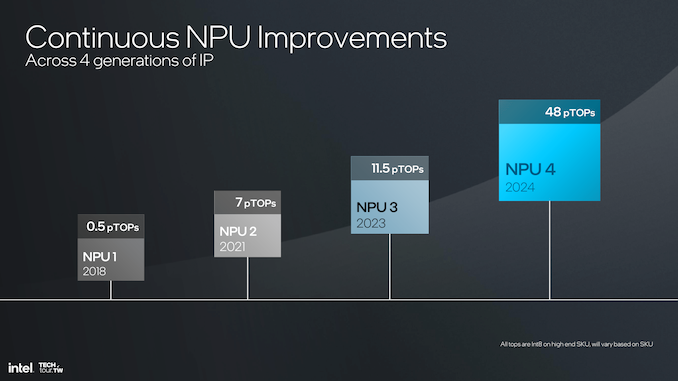
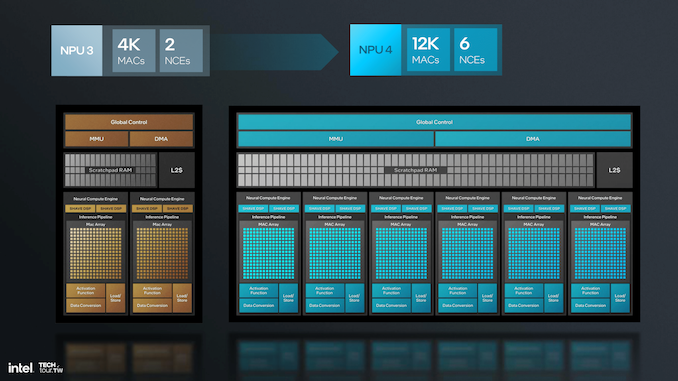
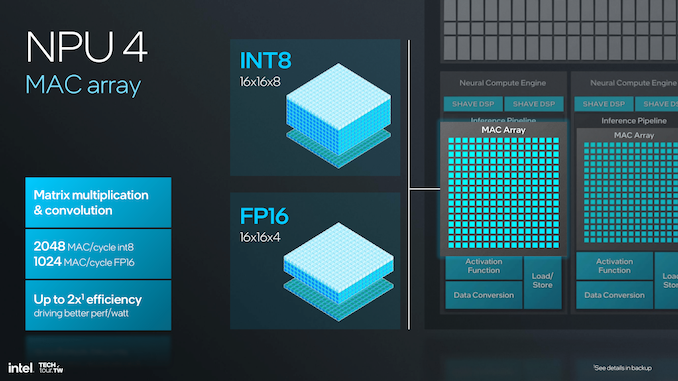
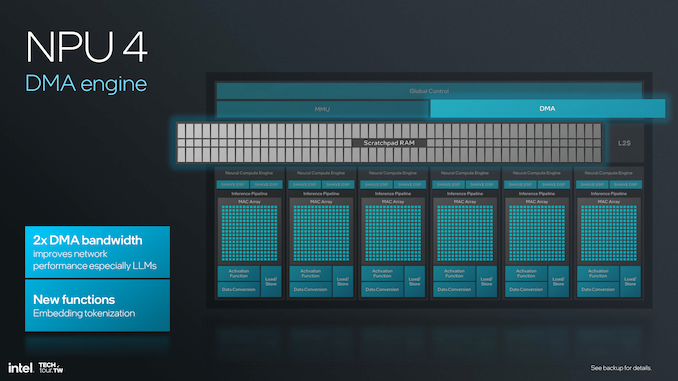

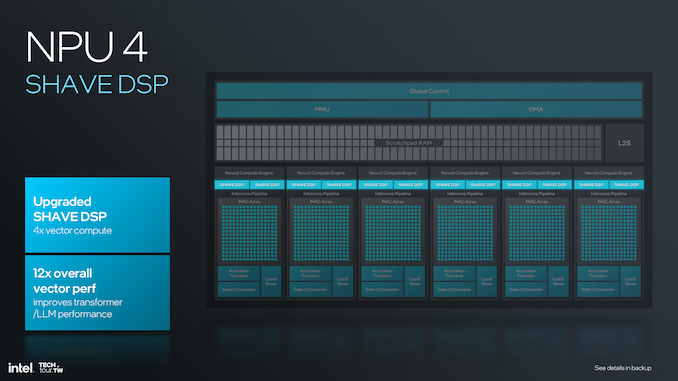
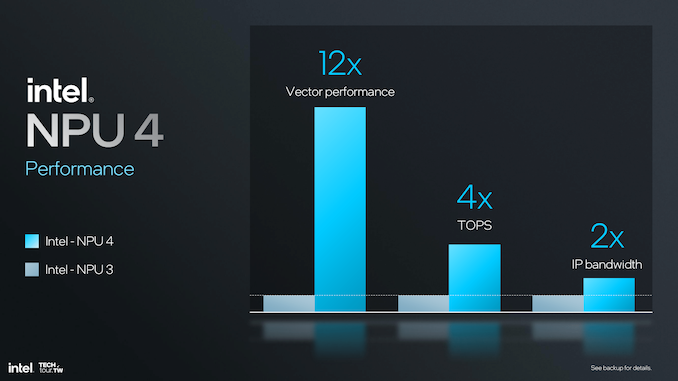








91 Comments
View All Comments
BushLin - Wednesday, June 5, 2024 - link
Seconded, also..."Gavin Bonshor - Tuesday, May 21, 2024 - link
Hey, thank you for saying that. They are coming as soon as I can get the data updated. I had to fly out to the USA last Monday evening, and the testing wasn't finished in time. I also don't typically work weekends, but I made an exception in this case. I'm catching up, but don't worry, it will be updated ASAP." Reply
TheinsanegamerN - Monday, June 10, 2024 - link
Nope. We never got that Macbook review or the return of the GPU benchmarks. Replyjaj18 - Tuesday, June 4, 2024 - link
What's the improvement from on package memory🤔? Replyrgreen1983 - Tuesday, June 4, 2024 - link
Power savings. Trading upgradeability for unplugged battery life because publications put way too much emphasis on it for years trying to make arm seem better than x86. ReplyThe Hardcard - Wednesday, June 5, 2024 - link
There’s not way to emphasis on it. Battery life is a far more mainstream issue than upgradability. Replyrgreen1983 - Wednesday, June 5, 2024 - link
I disagree. Battery life beyond a certain point is silly in a laptop, they aren't phones or tablets, which are much better suited for unplugged use for media consumption. Who the heck is spending 20 hours unplugged browsing the web? And at power performance than they would have if they were plugged in. I have supported thousands of laptops, lots of them macs, and any that do real work are plugged in.Battery life used to be measured in minutes and was a big deal but now that we are measuring near days it's getting silly. Reply
The Hardcard - Thursday, June 6, 2024 - link
People work plugged in because they have to, not because they want to. as more powerful workload, capable all day and multi day, devices become available, they will be the choices for huge numbers of people who can afford the price.Once all the players jump in, and there is more competition in price, extended battery life devices that can be worked on will dominate. Reply
TheinsanegamerN - Monday, June 10, 2024 - link
Maybe you want a battery that can still do a 8 hour workday 5 years after you bought it? Battery degradation is a thing you know.I could throw your question right back at you. Why does anyone need upgradeability on a modern laptop? CPUs last a LONG time, by the time the CPU is no longer fast enough, the whole generation will be unsupported anyway, and the device a relic of the past. Just buy enough memory to do what you need and use the machine.
See how easy that is? Reply
shabby - Tuesday, June 4, 2024 - link
Thanks tsmc for saving Intel's butt, they couldn't do it themselves with 10nm+++++++ ReplyNate_on_HW - Tuesday, June 4, 2024 - link
I found it interesting that they also talked about the INT8 OPS throughput of the GPU and CPUWould find it interesting to get those numbers on AMDs &Qualcomms chip and maybe plot each module of the SoCs as "TOPS/Watt" (for comparison)
I wonder if the new windows11 "on-device ML-models" would use the whole chip for computing or only the NPU. Reply